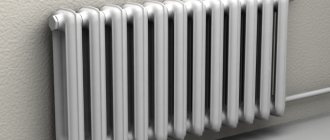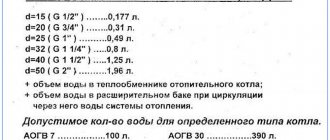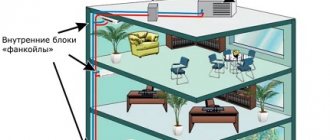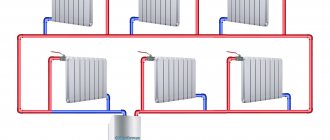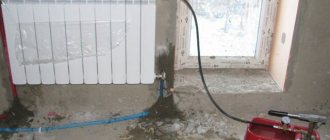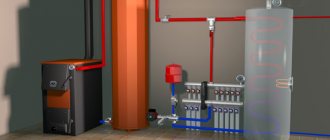About preventing freezing
A very important aspect is the choice of pipes for the heating system of the building. The weakest point of all pipes is corrosion processes. The most durable material is cast iron; according to manufacturers of cast iron batteries, they can last up to 100 years. The least resistant is aluminum, whose service life is about 10 years. Steel batteries will last you 25 years. Plastic pipes are not subject to corrosion, scale is not deposited in them, and they will last 50 years.
In addition, such pipes will not burst if the heating system needs to be defrosted - only a slight swelling will be visible in that place.
The owner of the house must be personally present at the moment when the heating system of a private house is launched. First of all, you need to pay attention to the welded joints, as well as how the pipes are laid in the trenches. Before filling them, you need to make sure that the thermal insulation of the pipes is in the gravel “backfill”.
Otherwise, deformation or even rupture may occur. It is also necessary to check how reliably the threaded connections of heating systems are sealed in areas where welding is not required.
Main causes of freezing
There are quite a few of them, and not all of them are the fault of the residents themselves (although valiant utility workers most often blame their sins on us). We also note that a whole complex of problems often leads to trouble, among which several main ones stand out:
- Human factor (end users, building residents).
- Service provider company.
- The factor of chance.
- Dilapidated heating system
Human factor
In each basement of an apartment building there are special ventilation holes - vents that are needed for ventilation. In the summer, they “work” for their intended purpose, and in the winter (i.e., during the heating season), they are supposed to be closed. But neither the utility workers nor the residents themselves often deal with such “little things” - and that’s fine.
As long as the temperature holds, the situation remains under control. But as soon as the frost hits, the cold penetrates the basement and begins to actively freeze it out. Ice crystals appear in the pipe, which quickly grow and completely block its lumen. If you're lucky, the integrity of the channel will not be damaged, and the answer to the question of how to defrost the heating system will be found quickly enough. If you “pulled out a lucky ticket,” the pipe breaks into pieces (you remember that water expands when it freezes?) with all the ensuing consequences.
Service provider company
It happens that the initial temperature of the coolant is lower than the standards. By the time it reaches the consumer, the temperature will drop even more. In this case, the remaining heat is simply not enough to resist severe frost, and the situation will follow the standard pattern (see the previous section).
Random factor
If the air temperature in the conventionally “warm” region of the middle zone fell to -40 degrees, no one is to blame for this. But because of this, pipes that worked normally at -20 are unable to resist the cold and begin to freeze. If this weather continues for several days, trouble can be expected.
Dilapidated heating system
Pipe systems in many cities have not changed for decades, which is why communications have simply exhausted the resource inherent in them. Thus, a significant narrowing of the pipe diameter leads to a drop in outlet temperature, and a violation of thermal insulation leads to the appearance of ice crystals. What comes next - you already know.
What other reasons can lead to water freezing in the heating system (this time -0 without searching for a specific “culprit”):
- Insufficient or damaged pipe insulation
- The level of the heating main or its segment is your soil freezing point
- Untimely draining of water from the circuit
- Hidden problems that do not outwardly manifest themselves for a long time (for example, a decrease in the efficiency of heating pipes or a background leak on the route). The last case is the most difficult, since not all communications are equipped with polyurethane foam insulation, which helps to detect the location of the breakthrough. And finding it in winter, when the roads are covered with a meter-thick layer of snow and ice over an area 2-3 kilometers long, is another “pleasure.”
Equipment for quick defrosting of the heating system
With the help of one of these devices, you will have the most modern and fastest defrosting method - within a few minutes, ice plugs in the pipes will be removed. With the use of such devices, an electric current is passed through the defrosted pipes at low voltage; the current strength should be equal to 400 Amperes.
The power depends on the length of the pipe - it can be adjusted from 1.7 to 4 kW.
If defrosting is necessary in pipes of large diameters, then they resort to using several devices simultaneously. The duration of this process is half an hour. The main thing is that the sealing of threaded connections of heating systems is not broken during defrosting.
Unconventional methods
There are often situations when a pipeline freezes and immediate action is required, but the appropriate equipment is not at hand. How to defrost a water pipe in such a situation? In this case, many begin to look for a way to cope with the problem using improvised means. It could be:
- Blowtorch (for metal pipes);
- Electric convector;
- Hot water;
- Construction equipment and even a hair dryer.
But you need to know
After all, freezing could lead to damage at the joints. It is not recommended to use diesel or gas heaters and open flame sources for defrosting.
The process itself should start from the mixers and taps - this will allow the melted water to drain from the system. After defrosting, the line must be checked for leaks and only then put into operation.
If a pipe located in the ground freezes, you will have to dig a trench, which is very problematic to do in the winter season. Therefore, it is better to take care of insulating water pipes in advance.
After opening it, pay attention to the material from which the pipeline is made. After all, various equipment is used to defrost polyethylene and metal pipes
For the former, electric heaters with a temperature not exceeding 100°C are most often used. In addition, you can use insulation of water pipes, this will speed up the thawing process.
Heating of metal areas is carried out using an open fire. This can be either a blowtorch or firewood.
How to avoid the effects of frost
The most reliable way to avoid such problems is to use frost-resistant pipes complete with a heating cable. This combination will forever save you from the need to defrost the water supply. Typically, such cables are turned on when necessary, and in warm weather they are inoperative.
A cheaper way is to use insulation for water pipes; the price of such materials is relatively low.
Among the most popular methods of insulating water pipes it is worth noting the use of:
- Glass wool;
- Basalt insulation;
- Expanded polystyrene;
- Thermal insulation paint.
The choice of a specific one depends on the characteristics of the pipeline laying. For example, glass wool is recommended to be used for metal-plastic products, and one layer of paint replaces polystyrene when insulating a water pipe on the street.
https://youtube.com/watch?v=6wF_AjhfYnQ
- For underground installation, the ditch is made in such a way that its depth is below the soil freezing level;
- The line should run at a distance from reinforced concrete structures - this will significantly reduce the likelihood of freezing;
- Areas where pipes pass through walls must be insulated;
- The diameter of the pipeline should not be less than 50 mm;
- For outdoor installations, it is recommended to use polyethylene that is not afraid of freezing;
- During seasonal use, the water must be drained.
By adhering to all these rules and insulating the line running outdoors, you can avoid freezing of the system, and, consequently, problems associated with their defrosting. But insulation for pipes will also not be superfluous.
Anti-icing and network heating systems
There is one more unfavorable nuance: pipes burst, which subsequently washes away the house structure with water, and the foundation is eroded. Next, you will need to carry out serious repairs, which will entail impressive amounts of costs. To avoid such an unpleasant moment, you can use a system of anti-icing and network heating of pipes.
To ensure continuous external defrosting of the heating system, a heating device such as a resistive series cable is used.
This system is good to use for pipes of considerable length. If compact heating is required, a self-regulating cable can be used.
To ensure anti-icing in drinking water pipes, a cable of this type is laid directly inside the pipes.
How to prevent freezing
To prevent freezing, first of all, it is necessary to correctly approach the layout and design of the heating system. It is advisable to purchase an auxiliary power supply. This is especially worth considering for those who experience frequent power outages. Using these simple tips, you can prevent system downtime. And, consequently, freezing of the heating system.
When constructing a heating system, it is necessary to use only high-quality materials. For example, it is not recommended to use aluminum pipes as they have a short service life. Usually it does not exceed 10 years. The highest quality are cast iron pipes and radiators. They have a service life of more than 50 years. Copper and steel pipes are less reliable. Their service life usually does not exceed 20 years. When using low-quality water, the service life of pipes is significantly reduced. Metal pipes are more susceptible to corrosion than others.
Plastic pipes are considered the most profitable. They do not corrode and have a service life of more than 35 years. Once pipes are defrosted, metal pipes often collapse. And plastic pipes can only swell a little. This is another advantage of such pipes.
The main means of protecting heating system pipes from freezing is high-quality thermal insulation. When installing pipes, the following rules must be observed: pipes must be laid on a bed of crushed stone and must be covered with thermal insulation. Pipe joints are more susceptible to freezing.
Methods for defrosting pipes
Each stage of defrosting pipes must comply with rules that must be followed. For example, how to check the tightness of the heating system during defrosting. If you decide to defrost yourself, you need to adhere to the following:
- Before defrosting, fully open the tap, which is located directly near the place where the water freezes in the pipes.
- Defrosting should be done slowly, gradually moving from the unscrewed tap to distant areas of the frozen pipe.
- The temperature does not need to be very high, it should be approximately such that a person can touch the pipe with his hand.
- When a pipe overheats, steam is formed; if the pressure created in the pipe is excessive, it can rupture, similar in nature to an explosion.
The simplest defrosting option is to turn on the autonomous heating system. When the house begins to warm up, the pipes themselves will go through the defrosting stage.
A fairly effective way to defrost in wooden floors or walls is to install electric lamps with a reflector that reflects heat energy. Electrical wiring is designed for power exceeding that used for an electric lamp.
Each of the listed defrosting methods is allowed to be used for metal-plastic pipes.
The temperature of such pipes during defrosting should not exceed 120 degrees.
More on this topic on our website:
- Collector heating system for a two-story house Heating affects comfortable and cozy living in the house. Therefore, the choice of heating your home must be approached with all seriousness. If your home has...
- The Leningrad heating system, the scheme of which is widely used in multi-storey and private buildings, is one of the most common schemes for organizing heating in buildings. Heating by…
- Gas heating is characterized by its low cost of energy, but is inferior to electric heating in terms of accessibility to the general population, ease of installation and ease of operation. Therefore, for many citizens of our country, electric...
- A country house can be a building equipped with various communications and high-quality furniture, but all luxury will become meaningless if the housing is not heated or the heating system is not...
Freezing pipes
Replacing main heating batteries has always caused a lot of difficulties along the way. After all, in order to simply replace an old or faulty heating device, it was necessary to drain the liquid from the system, and during the heating season, completely leave all neighbors without heat during the construction work.
Today, all such methods are a thing of the past - they have been replaced by an unusual way to change the battery indoors, regardless of the time of year. This is pipe freezing using the Rothenberger ROFROST TURBO 62206 electric apparatus.
How it works
When the pipes leading to the heat exchanger freeze, there is no need to close the risers and drain the water, which quite often becomes a technically complex and challenging task. The pipe sealing apparatus freezes some areas and forms strong ice plugs at their outlet. Next, the heating battery replacement specialist simply cuts off the heating device near the place of freezing and demolishes it. You can begin the process of installing a new heating device immediately, which will significantly save time on repair work.
The method of freezing pipes in our time is considered the best, inexpensive and successful when replacing heating batteries in Moscow. He has a lot of good qualities:
- the device does not stop working very quietly, without disturbing either apartment residents or office employees, or their neighbors;
- within 10 minutes after freezing, you can begin work on replacing the battery;
- the device provides uniform icing;
- You can freeze steel, copper, plastic and metal-plastic pipes.
Likewise, changing the battery is not difficult even during the height of the heating season
However, you should only trust specialists to work with the Rothenberger ROFROST TURBO 62206 unit, since during the freezing process you need to take into account certain nuances
Precautions when performing battery replacement work
Replacing pipes and heating devices for main heating is the most important process. The freezing method solves a lot of problems and inconveniences, but you must always remember the rules for performing such work:
- it is impossible to freeze pipes with a diameter greater than 65 mm, since they most likely will not withstand the pressure of the ice plug;
- It is prohibited to carry out welding work at a distance of less than 1 m from the ice plug, which can lead to heating and depressurization of the system;
Close-up view of freezing - see what's inside and how it works.
At the site of the ice plug formation and not far from it, you should not knock on the pipe with heavy objects, which will damage its integrity.
If you need additional advice on the plumbing services provided, write or call us:
Defrosting a small diameter plastic pipe
The question of how to defrost ice in a plastic pipe, also of small diameter (20 mm), in which water freezes more often than in large ones, can be solved in an original way.
But only with the participation of a professional electrician.
- We connect the two-core copper wire to the plug for the socket.
- If the length of the water pipe is up to 40 meters, it is advisable to use a car compressor and a car fuel hose with a diameter of 8 mm to blow out all the thawed water from the pipe. You can use a pump instead of a compressor.
- Next, remove the insulation (top) from the wire, then expose one wire, and carefully bend the second with insulation along the wire in the opposite direction. Then, using the bare wire at the very edge of the wire, we make up to 5 turns close to each other, and remove the excess end.
- Stepping back from the wound turns of the first wire by 3 mm, we expose the second wire and wind it in the same way. The main thing is that these wires do not touch and short-circuit. By the way, this defrosting method is dangerous and unacceptable for heating pipes.
- Then at the opposite end we attach a plug to the wire and the device is ready. The popular name for the resulting device is “burbulator”. When current passes through water, a huge amount of heat is released in the pipe. The main advantage of the device is that the wires remain cold, and only frozen water is heated, which prevents even accidental melting of a plastic pipe.
- Before use, test the device in a basin of water. If bubbles come from the contacts and a buzzing sound is heard, then the device is working. Caution: voltage! Turn it off.
- Now you can push the wire into the pipe until it reaches the ice. Press lightly so that the wire does not bend. Therefore, in this case, a thick wire section is better for defrosting.
- Then we plug the “burbulator” into the outlet, lightly pressing on the wire so that the device is located directly next to the frozen area. After about a minute, press harder on the wire, and it will gradually fall inside the pipe.
- After 1.5 meters, it is necessary to blow out excess water with a compressor in order to speed up the process. After all, there is no need to heat the thawed water, and it will not begin to freeze again in the thawed areas at the beginning of the pipe.
Do not even lay frost-resistant pipes near supports, foundations, beams, grillages - any reinforced concrete structures, since the thermal conductivity of concrete is an order of magnitude higher than the thermal conductivity of the soil, and this contributes to the freezing of the pipe in the ground from such building structures.
Non-freezing coolant in the heating system. Salvation or damnation?
- home
- Articles
- Non-freezing coolant in the heating system. Salvation or damnation?
21.03 2016
Over the 20 years that have passed since Vaillant began operating in Russia, the relevance of the problem remains. Or maybe, judging by the growing number of offers on the market of non-freezing coolants, it is not weakening, but growing. The problem is primarily the quality and continuity of power supply. Every user has a completely justified desire to protect their home from the consequences associated with defrosting heating systems. Has our position changed along with market developments?
The answer is categorical, but from a technical point of view it is justified: Vaillant prohibits the use of any coolants other than water in boilers of any type. And for 20 years now, day after day, we have been patiently explaining our unchanged position on this issue.
Let's take a closer look at Vaillant wall-mounted boilers.
When designing a heat generator, developers are guided by the basic physical principles of heat and mass transfer. In the heat transfer process, the physical properties of the coolant play a significant role: specific heat, thermal conductivity, viscosity, density, coefficient of volumetric expansion. When choosing a coolant at the boiler design stage, we already fix certain properties of the heat generator and the features of its design.
Vaillant has chosen a universal, neutral, affordable and convenient coolant for private consumers - water. Its physical properties are taken into account in the design of the hydraulic components of the boiler and burner device; they are hard-coded in the boiler electronics memory device, which controls the operation and controls all processes occurring in the apparatus. For control and monitoring, VaiUant wall-mounted boilers use two or three temperature sensors, which are located on the primary (internal) circuit of the device, flow sensors for the heating fluid and heated water for the DHW system. Thanks to them, electronics receive information about the absolute values of temperatures, their differences, and the rate of change. And based on this data, management is carried out. Any deviation of the physical properties of the coolant from the standard ones recorded in the ROM and inherent in water causes, as a consequence, the incorrect performance of all control functions associated with it.
We do not intend to in any way offend the interests of manufacturers of non-freezing coolants, but, nevertheless, we believe that the claimed complete identity of coolants with water and the stability of all physical properties in a certain temperature range cannot be achieved in principle. In addition, heating systems usually use solutions of similar coolants. The issue of maintaining the required optimal concentration of antifreeze in the heating system in the vast majority of cases lies with the private consumer. And he most often does not have a full understanding of the importance and seriousness of the problems caused by non-compliance with the requirements of manufacturers of antifreeze and heating system components. This attitude is inherent not only to the end user, but also to many other participants in the process of creating and operating a building heating system: designers, sales managers, installers, commissioning engineers, and service specialists.
For example, a designer who is not informed about the client’s desire to operate a future heating system with antifreeze cannot provide in the calculations for the corresponding changes in the heat transfer of heating devices, hydraulics, and heat generator modes. Accordingly, he cannot choose the right materials, which in practice threatens to significantly reduce the quality of the system, and sometimes leads to its complete inoperability. The installer will not use materials and technologies that guarantee the tightness of detachable connections during the life of the system. This will lead to numerous leaks.
One of the common consequences of using antifreeze is corrosion of system elements.
A heating system assembled without taking into account the specifics of a non-freezing coolant begins to lose coolant after some time: standard gaskets and threaded connections do not hold liquid with a low viscosity relative to water (including the gaskets used in Vaillant wall-mounted boilers). Forgetting or not knowing about the corrosive activity of a low concentration antifreeze solution, in which corrosion inhibitors stop working, the consumer replenishes the system not with a solution of the design concentration, but with fresh, oxygen-containing water.
In combination with inactive inhibitors, fresh water further aggravates the problem. Through corrosion damage to the metal parts of the system occurs. Sometimes, even after understanding the scale of the beginning destruction, we are no longer able to save the system even by chemical flushing followed by replacing the antifreeze with water. The service life of such a system is significantly shortened during operation with antifreeze.
Corrosion products circulating through the system are usually insoluble. They form deposits on system components, leading to their inoperability. The most intense deposits occur in the hottest part of the system - in the primary heat exchanger of the boiler.
A modern wall-mounted boiler has a compact and powerful heat exchanger, which means very high specific heat loads on its surface. The load on it already increases due to the fact that when another fluid circulates in the system, the heat transfer coefficient decreases. And deposits of corrosion products in such a heat exchanger can quickly lead to malfunctions and failure of the heat generator components.
You should also pay attention to the phenomenon of thermal destruction of glycol coolant, which occurs due to deterioration of heat transfer. The consequence of destruction is the decomposition products of the coolant, polluting the system. In wall-mounted boilers, due to the high specific heat load of the heat exchange surface, this phenomenon will begin immediately from the moment of commissioning.
It should be added that everything said applies to floor-standing boilers.
Our partners and clients may object to us: “You allow the use of antifreeze with Protherm boilers!” Why not with Vaillant?
The answer will seem to some like bureaucratic chicanery. But I still consider it necessary to bring it up again. Yes, we allowed the use of non-freezing coolant with Protherm boilers. You just need to carefully read every word of this permission.
First and most importantly , only two types of coolant were tested in the laboratory and only with certain types and models of boilers. This means that any other coolants cannot be used. This also means that the tested coolants cannot be used with boilers that are not on the “approval list”.
Secondly , when changing the model range, the automatic extension of permission to use to new models has no basis and is a delusion of those who think that the previous permission is valid.
Third , the approval for the use of coolant concerned only and exclusively the durability of materials during the warranty period. That is, the manufacturer disclaims responsibility for deviations of consumer properties from those stated in the technical documentation and does not guarantee the preservation of the durability of materials throughout the entire declared service life of the product.
Another argument against non-freezing coolant is the impossibility in real conditions of protecting the water supply system from defrosting.
A large percentage of modern autonomous heating systems are also involved in the preparation of hot water. Failure or shutdown of the heating system will not lead to instant freezing of water in the building. Due to the thermal inertia of building structures, the building retains thermal energy for some time. This time can sometimes be quite significant, and antifreeze, in fact, is not yet needed. If the building has cooled down so much that the water begins to freeze, the antifreeze in the system will no longer save the water supply.
Let’s not talk much about the fact that defrosting the heating system is a disaster for the building and colossal losses for the owner.
It's easy to ban. But is there a solution? We see it in Russia in measures to increase the reliability of power supply and heat supply systems as a separate engineering complex. As practice has shown, the main risk that the user sees is loss of power supply. In our conditions, such an accident poses the greatest threat to the reliable operation of the building. Currently, the market offers a wide range of solutions, differing in both price and quality, designed specifically for household heating devices.
In case of an accident in the fuel supply systems, gas supply or in the heat generator itself, an alternative may be the redundancy of additional heat generators using a different type of fuel or cascade schemes with several boilers. This, naturally, significantly increases the cost of the system and complicates its installation. The final say in choosing such a solution lies with the user.
Some consumers definitely want to use non-freezing coolants in radiator heating systems. For example, there is no alternative to them for the so-called “dacha” operation, when the heating system is turned on rarely and for a short time in the winter, and there is no water supply in the house. Vailant Group Rus LLC reminds such clients that antifreeze in the heating system is a violation of the requirements of technical documentation. The manufacturer's warranty does not apply in such cases.
However, we cannot ignore the wishes of consumers regarding the properties of our products. We continue to search for a solution for such a large group of potential buyers who need an inexpensive, energy-independent solid fuel boiler that can work with antifreeze. We hope to receive such a “country” boiler in our range in 2021.
Semushev V.V., Director of the technical department of Vailant Group Rus LLC. Based on materials from the magazine “Plumbing. Heating. Conditioning".
To the list of articles
Other articles
16.05 Energy efficient water heaters HAJDU
28.12 “Superpipe” in the service of the people. XLPE pipes produced by METZERPLAS (Israel)
21.11 RETRO cast iron radiators are always in demand. The solution to modern heating in the style of antiquity and sophistication can be a cast iron radiator, the artistic casting of which was created according to drawings and drawings from the turn of the century.
25.10 Review of Bosch gas instantaneous water heaters
